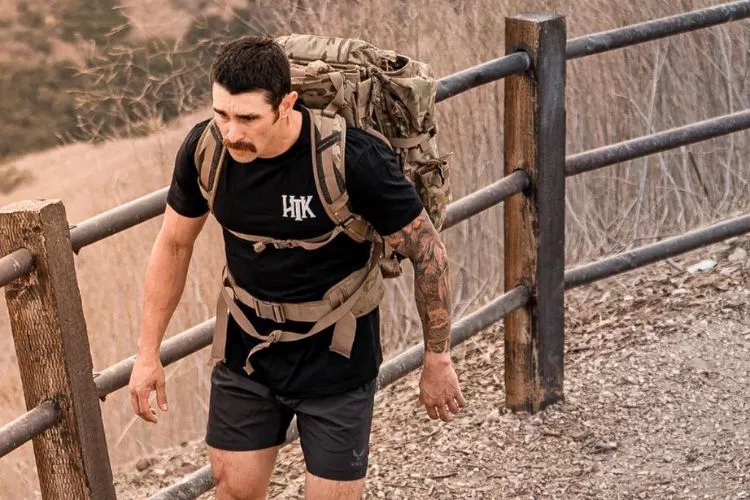The debate between using a rucksack and a weighted vest has continuously surfaced.
This article is about ruck vs weighted vest, and it explores the distinct benefits, drawbacks, and key differences of each to help fitness enthusiasts make an educated choice.

Whether you’re a military personnel seeking efficient training, a hiker looking to build endurance, or a workout aficionado seeking to spice up your routine, understanding the nitty-gritty of a ruck vs a weighted vest can influence your performance and results.
Dive in to discover which suits you best according to your workout regime and personal goals.
Ruck vs weighted vest: A Detailed Study
Comparing rucksacks and weighted vests entails an understanding of their design, usage, effectiveness, safety, versatility, and cost. Let’s explore these factors separately:
Design
- Rucksack: A ruck—short for rucksack—is essentially a backpack designed to carry weight during cardiovascular activity. The weight is concentrated primarily on the back.
- Weighted Vest: A weighted vest is a wearable vest with pockets to add weight. It distributes the weight across the torso on the chest and back.
Usage
- Rucksack: Rucks are predominantly used by the military or extreme hikers for training purposes and to build endurance.
- Weighted Vest: Weighted vests are widely used in functional training, high-intensity interval training, cardio workouts, and bodyweight exercises.
Effectiveness
- Rucksack: Rucking develops resilience and real-world fitness as the weight engages diverse muscle groups and requires constant energy output. It’s advantageous for building lower body strength and improving cardio fitness.
- Weighted Vest: The symmetric weight distribution enhances resistance during workouts and increases the efficacy of exercises aimed at the core, chest, and legs. It can add intensity to even the simplest workouts.
Safety
- Rucksack: If not used correctly, a rucksack may cause back strain and fatigue due to uneven weight distribution and load on the spine.
- Weighted Vest: Since the weight is distributed evenly around your torso, it maintains the body’s center of gravity and reduces the probability of injury.
Versatility
- Rucksack: Rucksacks facilitate variability in weights used and can double as a functional backpack for hiking or traveling. However, they lack application flexibility.
- Weighted Vest: Vests are mainly relevant in various fitness contexts, offering the ability to escalate simple body-weight exercises to complex strength training routines.
Cost
- Rucksack: These are generally cost-effective, but the prices may vary depending on brand and quality.
- Weighted Vest: These are usually more expensive due to their specialized design for fitness purposes.
In conclusion, choosing between a ruck and a weighted vest depends on individual fitness goals, preference, safety considerations, and budget. Your choice should complement your training regime and contribute positively to your desired results.
Sure, presenting the given details using subheadings:
Rucking refers to carrying a loaded backpack or rucksack while walking or hiking, introducing an external load to the body. This practice is commonly utilized in military training for its endurance and strength-building benefits.
For fitness enthusiasts, rucking can enhance a cardio routine, but it primarily engages and develops the muscles in the lower body.
Understanding Rucking
Rucking refers to carrying a loaded backpack or rucksack while walking or hiking, introducing an external load to the body. This practice is commonly utilized in military training for its endurance and strength-building benefits.
For fitness enthusiasts, rucking can enhance a cardio routine, but it primarily engages and develops the muscles in the lower body.
Understanding Rucking
Weighted vests, being garments worn over the torso with pockets for weights, distribute their load evenly across your body. This makes them ideal for a broader range of exercises, including push-ups, pull-ups, and squats.
They deliver versatile resistance, engaging your core and improving agility, which is a crucial aspect not offered by rucking.
Making the Choice: Ruck or Weighted Vest?
On balance, your choice between a ruck versus a weighted vest relies on your specific fitness goals, personal preferences, and nature of your training.
If cardio, endurance and a realistic hiking or military training experience is your aim, rucking could be beneficial. For strength training, functional fitness, and versatility in exercise selection, a weighted vest would be a more effective choice.
What are the cons of rucking?
Rucking does come with its share of negatives:

- Back Strain: Rucksacks put a considerable amount of stress on your back since the weight is largely concentrated there. This can lead to discomfort, and if sustained over a long duration, potential back injuries.
- Limited Versatility: Rucksacks are not best suited for a wide array of exercises. Their design makes them more conducive to walking and hiking routines.
- Uneven Weight Distribution: The weight in a rucksack can shift, causing an uneven distribution. This imbalance can potentially lead to posture issues and increased strain on certain muscle groups.
- Safety Concerns on Uneven Terrain: Rucking on uneven terrain with a heavy backpack can affect balance and stability, potentially increasing the risk of falls or injuries.
What are the negatives of weighted vests?
There are also some disadvantages to using weighted vests:
- Increased Joint Stress: Because they add weight to your core, weighted vests can increase stress on your knees, ankles, and feet during weight-bearing exercises, potentially leading to joint issues.
- Restricted Breathing: Some users may find that wearing a weighted vest can limit their ability to take deep breaths, particularly during vigorous exercise which could affect exercise performance.
- Discomfort and Fit Issues: Weighted vests may not fit perfectly on all body types, which could lead to discomfort during exercises. Ill-fitting vests can even cause chafing and limit movement.
- High Cost: Compared to rucksacks, weighted vests tend to be more expensive. The higher price tag could be a deterring factor for some individuals.
Is rucking with a vest better than a backpack?
Whether rucking with a vest is better than a backpack largely depends on several factors – your fitness goals, the types of exercises you perform, comfort preferences, and potential health concerns.

- Weight Distribution: One of the main differences between a vest and a backpack is the way weight is distributed. A vest disperses the weight evenly across your upper body – front and back. This helps maintain a center of balance, reducing the potential strain on specific muscle groups. A backpack, however, concentrates the weight largely on your back, which can lead to uneven stress distribution and potentially cause back discomfort if not properly managed.
- Versatility of Exercise: Weighted vests offer more versatility in terms of the exercises you can perform. They’re suitable for a broad range of movements including squats, burpees, push-ups, pull-ups, and high-intensity interval training exercises. Backpacks, on the other hand, are less ideal for these exercises due to their design and weight distribution. They are more suited for walking, hiking, or trekking.
- Realism and Specific Training Goals: If your goal is to mimic real-life conditions such as military training or backpacking trips, rucking with a backpack may offer a more realistic experience. The backpack accounts for the same weight and balance challenges you would experience in those scenarios.
- Comfort and Fit: Some individuals find a vest more comfortable because it fits closely to the body and moves less during workout. It can also be more readily adjusted to match the user’s body shape. A backpack may shift during movement, which can interrupt the flow of the workout.
- Injury Risk and Health Concerns: If you have pre-existing back or joint issues, you may want to consider using a vest because it distributes weight more evenly across your body. This can lessen the strain on your back compared to using a backpack.
In conclusion, the choice between rucking with a vest versus a backpack isn’t categorically ‘better’ or ‘worse’. It’s more about what suits your personal circumstance, requirements and exercise regimen best.
As always, it’s recommended to consult with a professional trainer or physiotherapist before starting a new workout regimen, especially when it involves additional weights.
Conclusion:
The choice between a ruck and a weighted vest largely pivots on your individual fitness goals and the exercise routine you follow. If your regimen involves activities like walking or hiking, and you aim to build endurance, a ruck serves you better.
Meanwhile, for a versatile range of functional fitness exercises, especially to boost core strength and agility, a weighted vest is a more beneficial choice.
Hence, no single method is superior; instead, it’s about finding the right fit for your personal exercise plan and comfort. As always, remember to exercise safely, keeping your body’s capacities and limitations in mind.


